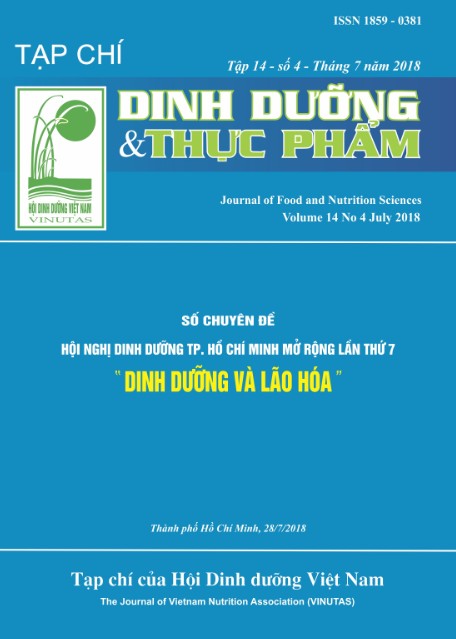ĐIỀU TRỊ DINH DƯỠNG CHO MỘT SỐ BỆNH THƯỜNG GẶP Ở NGƯỜI CAO TUỔI
Main Article Content
Abstract
The world’s population is ageing. It is predicated that between 2015 and 2030 the number of older people aged over 60 years will grow by 56% and that the number of older people with outnumber those aged between 0-9 years [8]. Poor eating habits accumulate over the lifecourse and can increase the risk of chronic conditions and disease. The prevention of chronic disease should commence early in life but optimal healthy eating and physical activity even over the age of 70 can significantly reduce morbidity and mortality.
The aim is to compress morbidity into the last years of life, extending the health span, that is, the number of years without disease and dysfunction.
There are a number of older people who are at risk of developing health problems as a result of inadequate food and nutrient intakes. In the aged there can be a decrease in lean mass and an increase in abdominal fat. This disorder can be described as protein energy dysnutrition (PED). It is associated with impaired immune responses, infections, poor wound healing, anaemia, osteoporosis/hip fracture, reduced cognitive function, delayed recovery from surgery, decreased muscle strength
(frailty) (risk factor for falls in the elderly) and ultimately increased morbidity and mortality. Protein-energy dysnutrition and sarcopenia can develop into frailty. Frailty is described as a multi-system reduction in reserve capacity of physiological systems where
there is at least three of the following five characteristics:poor appetite accompanied by weight loss; exhaustion;muscle weakness; slow walking speed and unsteady gait; andlow physical activity [2].
Maintaining adequate energy and protein intake is also the goal for the treatment of cancers, COPD and other conditions that may involve cachexia.
Neurological disorders are more likely to be present in aged persons, although can present at any time in the lifecourse.These conditions can impair an individual’s ability to chew and swallow as well as to prepare food and feed themselves. In the most severe forms feeding needs to occur via a nasogastric tube [6]. The use of nasogastric or total parenteral feeding needs to be balanced with quality of life, prognosis and the wishes of the individual and family.
For situations where an older person has dementia they may forget they have or have not eaten, forget how to use utensils, forget how to chew or swallow. In these cases assistance needs to be provided for the eating of meals and foods provided which can be eaten by hand.
There are a range of effects and impacts related to medications and the elderly. Nutrients and drugs can share some receptors for absorption, metabolism and excretion, resulting in food-drug interactions. The elderly are at more risk due to the number of medications they are prescribed [3].
A range of strategies have been developed within hospitals to optimise dietary intake among older inpatients these include protected mealtimes, assisted mealtimes, encouraging early mobility and functional independence, meaningful cognitive activities [10].
Article Details
Similar Articles
- Diệp Kim Quyên, STUDY ON PROPORTION OF SUPPLEMENTED PANDAN LEAVES AND BAKING SCHEME TO IMPROVE THE QUALITY OF OAT COOKIES , Vietnam Journal of Nutrition & Food: Vol. 15 No. 5+6 (2019)
You may also start an advanced similarity search for this article.


